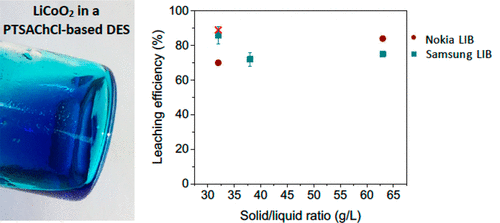当前位置:
X-MOL 学术
›
ACS Sustain. Chem. Eng.
›
论文详情
Our official English website, www.x-mol.net, welcomes your
feedback! (Note: you will need to create a separate account there.)
Highly Efficient p-Toluenesulfonic Acid-Based Deep-Eutectic Solvents for Cathode Recycling of Li-Ion Batteries
ACS Sustainable Chemistry & Engineering ( IF 7.1 ) Pub Date : 2020-04-01 , DOI: 10.1021/acssuschemeng.0c00892 María Jesús Roldán-Ruiz 1 , María Luisa Ferrer 1 , María Concepción Gutiérrez 1 , Francisco del Monte 1
ACS Sustainable Chemistry & Engineering ( IF 7.1 ) Pub Date : 2020-04-01 , DOI: 10.1021/acssuschemeng.0c00892 María Jesús Roldán-Ruiz 1 , María Luisa Ferrer 1 , María Concepción Gutiérrez 1 , Francisco del Monte 1
Affiliation

|
The common use of Li-ion batteries (LIBs) in portable devices and electric vehicles is promoting an exponential growth of the rechargeable batteries market. Their use in electric vehicles while not yet so common will be favored in the near future by government incentives aiming to mitigate global warming effects coming from combustion engines. Despite the remote risk of cobalt (Co) and lithium (Li) supplies running low, metals recovery from “postconsumer” scrap is a rapidly expanding topic in the political agenda within the context of the circular economy. Among other recycling technologies, processes using mild conditions and providing high recycling efficiencies are gaining increased interest. For instance, organic acids are particularly interesting for LiCoO2 dissolution even though they typically need the additional use of reducing agents. Herein, we explore the Co (and Li) recovery from spent LIBs using deep eutectic solvents (DESs) at temperatures as low as 90 °C, at times of dissolution as short as 15 min and without the use of any additional reducing agent. In particular, we used the eutectic mixture composed of p-toluenesulfonic acid (PTSA) monohydrate and choline chloride (ChCl) (e.g., PTSA·H2O·ChClDES with a 1:1:1 molar ratio) and aqueous dilutions thereof (e.g., PTSA·2H2O·ChClDES and PTSA·3H2O·ChClDES with 1:2:1 and 1:3:1 molar ratios, respectively). Compared to organic acids, PTSAChCl-based DESs offered a significant reduction of the solute to solvent ratio (in g/L) needed for full Co dissolution. This brings benefits both in economic and sustainable terms that handling low solvent volumes has in industrial processes. Interestingly, Co recovery efficiencies from spent LIBs reached figures of up to 94% over the whole process relating to the extraction from spent LIBs using PTSAChCl-based DESs, the precipitation with either Na2CO3 or (NH4)2CO3, and the final calcination to obtain Co3O4.
中文翻译:

基于高效对甲苯磺酸的深共溶溶剂,用于锂离子电池的阴极回收
锂离子电池(LIB)在便携式设备和电动汽车中的普遍使用正在促进可充电电池市场的指数增长。在不久的将来,由于政府旨在减轻内燃机产生的全球变暖影响的激励措施,它们在电动汽车中的应用虽然还不那么普遍,但将受到青睐。尽管钴(Co)和锂(Li)供应的风险极低,但在循环经济背景下,从“消费后”废料中回收金属是政治议程中一个迅速扩展的话题。在其他回收技术中,使用温和条件并提供高回收效率的工艺越来越引起人们的关注。例如,有机酸对于LiCoO 2尤为有趣即使它们通常需要额外使用还原剂也能溶解。在本文中,我们探索了使用低共熔溶剂(DES)在低至90°C的温度下,溶解时间短至15分钟且不使用任何其他还原剂的情况下,从用过的LIB中回收Co(和Li)的方法。特别是,我们使用了由对甲苯磺酸(PTSA)一水合物和胆碱氯化物(ChCl)组成的共晶混合物(例如PTSA·H 2 O·ChCl DES,摩尔比为1:1:1)及其水相稀释液(例如PTSA·2H 2 O·ChCl DES和PTSA·3H 2 O·ChCl DES摩尔比分别为1:2:1和1:3:1)。与有机酸相比,基于PTSAChCl的DES大大降低了Co完全溶解所需的溶质与溶剂之比(以g / L计)。这在经济和可持续方面都带来了好处,即在工业过程中处理少量溶剂。有趣的是,从废LIBS钴回收效率达到与从使用基于PTSAChCl-DESS,与任一钠沉淀花费LIBS提取在整个过程高达94%的图2 CO 3或(NH 4)2 CO 3,和最后煅烧得到Co 3 O 4。
更新日期:2020-04-01
中文翻译:

基于高效对甲苯磺酸的深共溶溶剂,用于锂离子电池的阴极回收
锂离子电池(LIB)在便携式设备和电动汽车中的普遍使用正在促进可充电电池市场的指数增长。在不久的将来,由于政府旨在减轻内燃机产生的全球变暖影响的激励措施,它们在电动汽车中的应用虽然还不那么普遍,但将受到青睐。尽管钴(Co)和锂(Li)供应的风险极低,但在循环经济背景下,从“消费后”废料中回收金属是政治议程中一个迅速扩展的话题。在其他回收技术中,使用温和条件并提供高回收效率的工艺越来越引起人们的关注。例如,有机酸对于LiCoO 2尤为有趣即使它们通常需要额外使用还原剂也能溶解。在本文中,我们探索了使用低共熔溶剂(DES)在低至90°C的温度下,溶解时间短至15分钟且不使用任何其他还原剂的情况下,从用过的LIB中回收Co(和Li)的方法。特别是,我们使用了由对甲苯磺酸(PTSA)一水合物和胆碱氯化物(ChCl)组成的共晶混合物(例如PTSA·H 2 O·ChCl DES,摩尔比为1:1:1)及其水相稀释液(例如PTSA·2H 2 O·ChCl DES和PTSA·3H 2 O·ChCl DES摩尔比分别为1:2:1和1:3:1)。与有机酸相比,基于PTSAChCl的DES大大降低了Co完全溶解所需的溶质与溶剂之比(以g / L计)。这在经济和可持续方面都带来了好处,即在工业过程中处理少量溶剂。有趣的是,从废LIBS钴回收效率达到与从使用基于PTSAChCl-DESS,与任一钠沉淀花费LIBS提取在整个过程高达94%的图2 CO 3或(NH 4)2 CO 3,和最后煅烧得到Co 3 O 4。










































 京公网安备 11010802027423号
京公网安备 11010802027423号